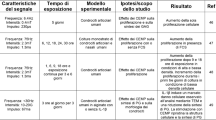Abstract
Severe joint inflammation following trauma, arthroscopic surgery or infection can damage articular cartilage, thus every effort should be made to protect cartilage from the catabolic effects of pro-inflammatory cytokines and stimulate cartilage anabolic activities. Previous pre-clinical studies have shown that pulsed electromagnetic fields (PEMFs) can protect articular cartilage from the catabolic effects of pro-inflammatory cytokines, and prevent its degeneration, finally resulting in chondroprotection. These findings provide the rational to support the study of the effect of PEMFs in humans after arthroscopic surgery. The purpose of this pilot, randomized, prospective and double-blind study was to evaluate the effects of PEMFs in patients undergoing arthroscopic treatment of knee cartilage. Patients with knee pain were recruited and treated by arthroscopy with chondroabrasion and/or perforations and/or radiofrequencies. They were randomized into two groups: a control group (magnetic field at 0.05 mT) and an active group (magnetic field of 1.5 mT). All patients were instructed to use PEMFs for 90 days, 6 h per day. The patients were evaluated by the Knee injury and Osteoarthritis Outcome Score (KOOS) test before arthroscopy, and after 45 and 90 days. The use of non-steroidal anti-inflammatory drugs (NSAIDs) to control pain was also recorded. Patients were interviewed for the long-term outcome 3 years after arthroscopic surgery. Thirty-one patients completed the treatment. KOOS values at 45 and 90 days were higher in the active group and the difference was significant at 90 days (P < 0.05). The percentage of patients who used NSAIDs was 26% in the active group and 75% in the control group (P = 0.015). At 3 years follow-up, the number of patients who completely recovered was higher in the active group compared to the control group (P < 0.05). Treatment with I-ONE aided patient recovery after arthroscopic surgery, reduced the use of NSAIDs, and also had a positive long-term effect.


Similar content being viewed by others
References
Aaron RK, Wang S, Ciombor DM (2002) Upregulation of basal TGFbeta1 levels by EMF coincident with chondrogenesis–implications for skeletal repair and tissue engineering. J Orthop Res 20(2):233–240
Buckwalter JA, Mankin HJ (1997) Articular cartilage: part I–II. J Bone Joint Surg 79-A(4):600–632
Ciombor DM, Aaron RK, Wang S, Simon B (2003) Modification of osteoarthritis by pulsed electromagnetic field–a morphological study. Osteoarthritis Cartilage 11(6):455–462
Cohen SB, Gill SS, Baer GS, Leo BM, Scheld WM, Diduch DR (2004) Reducing joint destruction due to septic arthrosis using an adenosine2A receptor agonist. J Orthop Res 22(2):427–435
De Mattei M, Pasello M, Pellati A, Stabellini G, Massari L, Gemmati D, Caruso A (2003) Effects of electromagnetic fields on proteoglycan metabolism of bovine articular cartilage explants. Connect Tissue Res 44(3–4):154–159
De Mattei M, Pellati A, Pasello M, Ongaro A, Setti S, Massari L, Gemmati D, Caruso A (2004) Effects of physical stimulation with electromagnetic field and insulin growth factor-I treatment on proteoglycan synthesis of bovine articular cartilage. Osteoarthritis Cartilage 12(10):793–800
De Mattei M, Fini M, Setti S, Ongaro A, Gemmati D, Stabellini G, Pellati A, Caruso A (2006) Proteoglycan synthesis in bovine articular cartilage explants exposed to different low-frequency low-energy pulsed electromagnetic fields. Osteoarthritis Cartilage [Epub ahead of print]
Fini M, Giavaresi G, Carpi A, Nicolini A, Setti S, Giardino R (2005) Effects of pulsed electromagnetic fields on articular hyaline cartilage: review of experimental and clinical studies. Biomed Pharmacother 59(7):388–394 (review)
Fini M, Giavaresi G, Torricelli P, Cavani F, Setti S, Cané V, Giardino R (2005) Pulsed electromagnetic fields reduce knee osteoarthritic lesion progression in the aged Dunkin Hartley guinea pig. J Orthop Res 23(4):899–908
Goldring SR, Goldring MB (2004) The role of cytokines in cartilage matrix degeneration in osteoarthritis. Clin Orthop Relat Res Suppl 427:S27–S36 (review)
Gomez G, Sitkovsky MV (2003) Targeting G protein-coupled A2a adenosine receptors to engineer inflammation in vivo. Int J Biochem Cell Biol 35(4):410–414 (review)
Henrotin YE, Bruckner P, Pujol JP (2003) The role of reactive oxygen species in homeostasis and degradation of cartilage. Osteoarthritis Cartilage 11(10):747–755 (review)
Radin EL, Rose RM (1986) Role of subchondral bone in the initiation and progression of cartilage damage. Clin Orthop Relat Res 213:34–40
Roos EM, Roos HP, Lohmander LS, Ekdahl C, Beynnon BD (1998) Knee injury and Osteoarthritis Outcome Score (KOOS)—development of a self-administered outcome measure. J Orthop Sports Phys Ther 28(2):88–96
Schuerwegh AJ, Dombrecht EJ, Stevens WJ, Van Offel JF, Bridts CH, De Clerck LS (2003) Influence of pro-inflammatory (IL-1 alpha, IL-6, TNF-α, IFN-γ) and anti-inflammatory (IL-4) cytokines on chondrocyte function. Osteoarthritis Cartilage 11(9):681–687
Setti S, Fini M, Giavaresi G, Cavani F, Bertoni L, Benazzo F (2006) Long term effects of pulsed electromagnetic fields on the integration of osteochondral autografts in sheep. The 6th ICRS symposium, San Diego P1-10
Tesch AM, MacDonald MH, Kollias-Baker C, Benton HP (2002) Chondrocytes respond to adenosine via A(2)receptors and activity is potentiated by an adenosine deaminase inhibitor and a phosphodiesterase inhibitor. Osteoarthritis Cartilage 10(1):34–43
Tesch AM, MacDonald MH, Kollias-Baker C, Benton HP (2004) Endogenously produced adenosine regulates articular cartilage matrix homeostasis: enzymatic depletion of adenosine stimulates matrix degradation. Osteoarthritis Cartilage 12(5):349–359
Varani K, Gessi S, Merighi S, Iannotta V, Cattabriga E, Spisani S, Cadossi R, Borea PA (2002) Effect of low frequency electromagnetic fields on A2A adenosine receptors in human neutrophils. Br J Pharmacol 136:57–66
Author information
Authors and Affiliations
Corresponding author
Rights and permissions
About this article
Cite this article
Zorzi, C., Dall’Oca, C., Cadossi, R. et al. Effects of pulsed electromagnetic fields on patients’ recovery after arthroscopic surgery: prospective, randomized and double-blind study. Knee Surg Sports Traumatol Arthr 15, 830–834 (2007). https://doi.org/10.1007/s00167-007-0298-8
Received:
Accepted:
Published:
Issue Date:
DOI: https://doi.org/10.1007/s00167-007-0298-8




